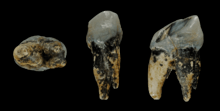Graecopithecus
| Graecopithecus freybergi Temporal range: Late Miocene | |
|---|---|
.jpg) | |
| Holotype jaw and premolar | |
| Scientific classification | |
| Kingdom: | Animalia |
| Phylum: | Chordata |
| Class: | Mammalia |
| Order: | Primates |
| Family: | Hominidae |
| Tribe: | Homininae |
| Subtribe: | Hominini |
| Genus: | Graecopithecus von Koenigswald, 1972 |
| Species: | G. freybergi |
| Binomial name | |
| Graecopithecus freybergi von Koenigswald, 1972[1][2] | |
Graecopithecus freybergi is a hominid originally identified by a single mandible found in 1944. Since then, analysis of tooth specimens has led to suggestions that Graecopithecus may be the oldest known direct ancestor of modern man,[3][4] though the claim is contested.[5]

The original Graecopithecus specimen mandible found in 1944, "reportedly unearthed as the occupying German forces were building a wartime bunker".[5] The mandible with a third molar that is very worn, the root of a second molar, and a fragment of a premolar is from a site called Pyrgos Vassilissis northwest of Athens[6][7] and is dated from the late Miocene. Excavation of the site is not possible (as of 1986) due to the owner having built a swimming pool on the location.[8]
G. freybergi is considered possibly the same as Ouranopithecus macedoniensis.[9][10][6] The hominid is the least well known of those found within Europe.[11]
An examination of the detailed morphology of molar teeth from two fossils of G. freybergi published in 2017[12] suggests that it may be a hominin, that is sharing ancestry with Homo but not with the Chimpanzees (Pan). This would call into question the prevailing belief that pre-human hominids originated in Africa, though others are sceptical of the claims.[5][13]
See also
| Wikimedia Commons has media related to Graecopithecus. |
| Wikispecies has information related to: Graecopithecus |
- Anoiapithecus
- Chororapithecus
- Dryopithecus
- Human timeline
- Life timeline
- Nakalipithecus
- Pierolapithecus
- Samburupithecus
Notes
- ↑ Andrews & Franzen 1984
- ↑ Cameron 2004, p. 184
- ↑ "Europe was the birthplace of mankind, not Africa, scientists find". The Telegraph. Retrieved 2017-05-28.
- ↑ http://journals.plos.org/plosone/article?id=10.1371/journal.pone.0177127
- 1 2 3 "Our common ancestor with chimps may be from Europe, not Africa". New Scientist. 2017-05-22. Retrieved 2017-05-24.
- 1 2 Casanovas‐Vilar et al. 2011
- ↑ de Bonis & Koufos 1999, p. 230
- ↑ de Bonis et al. 1986, p. 107
- ↑ Koufos & de Bonis 2005
- ↑ Smith et al. 2004
- ↑ Begun 2002, p. 361
- ↑ Fuss et al.
- ↑ "Scientists find 7.2-million-year-old pre-human remains in the Balkans". Phys.org. 22 May 2017. Retrieved 23 May 2017.
References
- Andrews, Peter; Franzen, Jens Lorenz, eds. (1984). The Early Evolution of Man: With Emphasis on Southeast Asia and Africa. Courier Forschungsinstitut Senckenberg, 0341-4116. 69. Senckenbergische Naturforschende Gesellschaft. ISBN 9783924500054.
- Begun, David R. (2002). "European Hominoids". In Hartwig, Walter. The Primate Fossil Record. Cambridge University Press. pp. 339–368. ISBN 9780521663151.
- Cameron, David W. (2004). Hominid adaptations and extinctions. UNSW Press. ISBN 9780868407166.
- Casanovas‐Vilar, Isaac; Alba, David M.; Garcés, Miguel; Robles, Josep M.; Moyà‐Solà, Salvador (April 2011). "An updated chronology of the Miocene radiation in Western Eurasia" (PDF). PNAS. 108 (14): 5554–5559. PMC 3078397
 . PMID 21436034. doi:10.1073/pnas.1018562108.
. PMID 21436034. doi:10.1073/pnas.1018562108. - de Bonis, L.; Bouvrain, G.; Koufos, G.; Melentis, J. (1986). "Succession and dating of the late Miocene primates of Macedonia". In Lee, Phyllis C.; Else, James G. Primate Evolution. Proceedings of the Tenth Congress of the International Primatological Society: Held in Nairobi, Kenya, in July 1984, International Primatological Society. Congress. 1. CUP Archive. ISBN 9780521324502.
- de Bonis, Louis; Koufos, George D. (1999). "The Miocene large mammal succession in Greece". In Agustí, Jorge; Rook, Lorenzo; Andrews, Peter. Hominoid Evolution and Climatic Change in Europe: Volume 1, The Evolution of Neogene Terrestrial Ecosystems in Europe. Cambridge University Press. ISBN 9780521640978.
- Fuss, J.; Spassov, N.; Begun, David R.; Böhme, M. (2017). "Potential hominin affinities of Graecopithecus from the Late Miocene of Europe". PLoS ONE. 12 (5). doi:10.1371/journal.pone.0177127.
- Koufos, George D.; de Bonis, Louis (July–September 2005). "The Late Miocene hominoids Ouranopithecus and Graecopithecus. Implications about their relationships and taxonomy". Annales de Paléontologie. 91 (3): 227–240. doi:10.1016/j.annpal.2005.05.001.
- Smith, Tanya M.; Martin, Lawrence B.; Reid, Donald J.; de Bonis, Louis; Koufos, George D. (2004). "An examination of the dental development in Graecopithecus freybergi (Ouranopithecus macedoniensis)". Journal of Human Evolution. 46: 551–577. PMID 15120265. doi:10.1016/j.jhevol.2004.01.006.